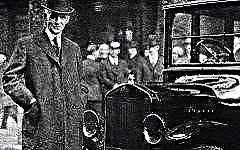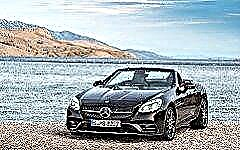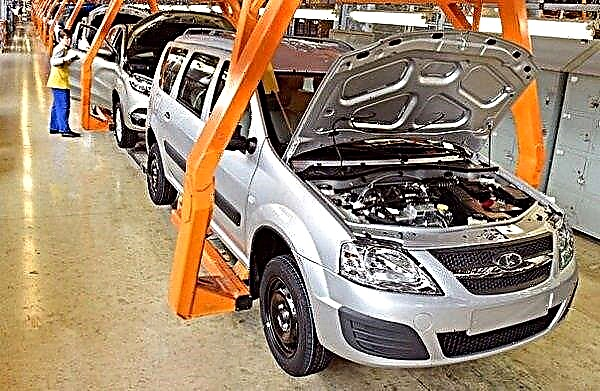

The content of the article:
- From chariot to socialism
- Czech kübelwagen
- Between "Volga" and "Chaika"
- A set of contradictions
- Convertible for the leader
The most famous Czech car manufacturer, the oldest car manufacturer in the world, one of the unique factories that has not changed its production course for a century and a half. This is all TATRA.
From chariot to socialism

The history of the company began in 1850 with the construction of first carriages, and later - carriages with various bodies. Crews made by the Czechs successfully dispersed throughout Europe, going, including to Russia.
After laying the railway lines, the company masters a new area for itself - the production of wagons. The first car appears only in 1897, which successfully passes all tests and starts a new era for the manufacturer.
Although Tatra is better known for its freight transport, the number of which in Russia alone in the twentieth century numbered 15 thousand units, there are very interesting cars in the company's model range.
Czech kübelwagen

The small car Tatra 57 was born in 1931 and soon became widespread due to its characteristics and cost. She just had 2 different lives: pre-war and military.
The civilian version was equipped with a nimble 4-cylinder engine capable of 80 km / h with a power of 18 hp.
By 1936, the car was added with 2 hp. and speed by an additional 10 km / h, and from 1937 to 1939 there was also a special modification with an open body.
And then a new round of development of the model began - German. After the troops of the Wehrmacht subjugated Czechoslovakia, they reoriented all production for military needs. Then the army version of the Tatra was created, which received the classic German K index from the designation of cross-country vehicles - kübelvagen. Now soldiers, police and even the highest command staff of the Wehrmacht, who greatly appreciated the car for its unpretentiousness and reliability, drove around on it.
The 57K version received a specific feature - its hood rose completely upward along with the fenders and headlights, providing access to both the power unit and the front suspension.
For greater maintainability, and at the same time to reduce the cost of production, the body was significantly simplified, removable frames with glass were installed on the doors, and the roof was replaced with a tarpaulin one. Thanks to such manipulations, the car "lost" by 60 kg.
Another advantage of the model was the speed, which exceeded the competitor - the development of Porsche - by 30 km / h. The car of the eminent Italian Tour 82 barely reached 60 km / h, while the Tatra easily accelerated to 90 km / h, while spending no more than 10 liters of fuel.
The car, ingenious in its simplicity, was appreciated at its true worth, and therefore, at the end of the war, it became a pleasant trophy for the American troops and for the Red Army.
Between "Volga" and "Chaika"

Some Soviet party leaders had a difficult time when it was not serious to travel in Zhiguli, and the Volga was intended only for the highest ranks. What could humble leaders do in such a situation? Tatra came to their aid.
The 613 was originally conceived as a representative class, had an engine in the rear, a specially developed design and a luxurious interior for those times. True, when the first modification began to become obsolete and the Czechs took up its modernization, the designers openly cheated... The Italian studio Carrozzeria Village, which was entrusted with the creation of a new image, just slightly modified the samples proposed by the manufacturer, without bringing in their own ideas.
The power unit was left in the same place, but the layout was changed. For a fairly large, long, moreover, rear-engined car, it turned out to be strikingly "lightweight". An original, memorable appearance, a body with excellent aerodynamic parameters and flawless lines. In the appearance of this "European" someone notices the features of Citroen, someone Saab - in any case, he invariably attracted attention on the road.
The front end, somewhat reminiscent of a seedling box, is questionable, especially when combined with the shorter rear end with Mercedes' fin-shaped headlights. By the way, the lights in an original way passed along the rear window, which provided the model with an element of fantasy.
But the interior was more than austere, which, however, was the best fit for a company car. With a meager dashboard, the salon had very comfortable front seats with high-quality upholstery and a spacious rear sofa.
At the heart of the car was a 3.5-liter V8 engine that produced 143 hp and a speed of up to 190 km / h. His disadvantage can be called not only capriciousness - he consumed only A95 gasoline - but also a remarkable appetite, amounting to up to 15 liters of fuel on the highway.
The entire internal structure of the 613 model can be called non-standard: 2 carburetors, an air cooling system carried out using a turbine, independent gasoline-powered stoves for heating the passenger compartment. And the level of automatic or 4-speed manual transmission could be compared to the best examples of Range Rover.
A set of contradictions

The legendary Tatra 87 had an equal number of fans and haters. This is partly due to the non-standard, far ahead of its time, especially for 1937.
The capsule, aerodynamic body resembled a space shuttle, a 3-sector windshield, huge "bulging" headlights - all this was so revolutionary that it attracted and repelled motorists in equal measure.
The driving performance was phenomenal too, far exceeding other luxury competitors: power of 75 hp, V8 engine, speed of 160 km / h, fuel consumption of 14 liters. Fantastic air intakes located at the rear were intended to cool the engine compartment, while a spacious luggage compartment provided soundproofing to the driver and his passengers.
This model became the first Czech car with an all-metal body, which made it possible to significantly reduce the weight of the model due to the abandonment of a wooden frame, an aluminum cylinder head, and the use of a magnesium alloy for the engine oil pan. At the same time, the car received more compact dimensions, which, nevertheless, comfortably accommodated 5 seats.
The few surviving Tatra 87 models are carefully kept in museums and by frequent collectors, participate in motor rallies and invariably cause affection for everyone who sees them.
Convertible for the leader

The year 1949 was marked by a magnificent celebration - the countries of people's democracies honored Joseph Stalin, who turned 70 years old. Many gifts from various parts of the world were sent to the great leader, including carpets, smoking pipes, daggers and, of course, cars.
4 cars arrived from Czechoslovakia to Moscow at once - Skoda, Tatra, Aero, EMV. Tatra, long before the significant event, began developing an exclusive sample worthy of getting into the garage of such an eminent person. It was a unique convertible, based on the chassis from a colleague known as Tatraplan.
The newest pontoon, streamlined body with an elegant shape with molding along the entire length, chic finish, powerful engine, fog lights on a false radiator grille. The distance between the seats was made wider for greater comfort, as was the door itself, as a result of which the car was slightly distributed in size. The seats were upholstered in real leather in deep red and had the equivalent of modern headrests.
For delivery to Moscow, the car was disassembled, partly brought into the capital, where it was reassembled just before the anniversary. Unfortunately, the hero of the day did not appreciate the gift - for fear of assassination, he disliked open-top cars, preferring an armored Pakkard or ZIS. Therefore, the convertible never went out on the road, after the death of the leader it was exhibited at the Polytechnic Museum, and then, thanks to the collector, went to its historical homeland.
Tatra cars do not lose their relevance to this day, although now they are mainly presented in a cargo version and in the form of an army transport.... The carmaker now manufactures its cars under the Terex-Tatra brand, and although it constantly faces financial, technical and organizational difficulties, it continues to defend its age-old traditions and unique style. Even if her name does not rattle in the car market, her positions are stable and unshakable due to the constant reliability, practicality and uniqueness of her models.
In Russia, Tatra cars have been loved and respected since the war, and therefore they sincerely want to believe rumors about the revival of the brand and the start of the production of new passenger cars.











